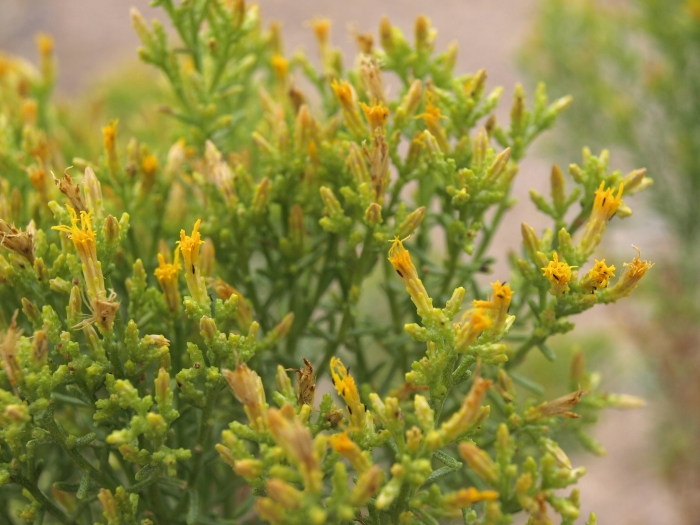Green Rabbitbrush
(Ericameria teretifolia)
Green Rabbitbrush (Ericameria teretifolia)
/
/

Jim Morefield
CC BY 4.0
Image By:
Jim Morefield
Recorded By:
Copyright:
CC BY 4.0
Copyright Notice:
Photo by: Jim Morefield | License Type: CC BY 4.0 | License URL: http://creativecommons.org/licenses/by/4.0/ | Rights Holder: Jim Morefield | Publisher: iNaturalist | Date Created: 2017-09-03T12:50:45-07:00 |

























Estimated Native Range
Summary
Ericameria teretifolia, commonly known as Green Rabbitbrush, is a perennial shrub native to the arid desert regions of the southwestern United States, including southern and eastern California, southern Nevada, and northwestern Arizona. It is particularly adapted to open habitats such as flat plains, rocky slopes, and canyon walls within the Mojave and Sonoran Deserts. This shrub typically grows up to 5 feet tall and wide, with a rounded form that becomes more open with age. Its distinctive foliage consists of narrow, thread-shaped, terete (circular in cross-section) leaves that contribute to its overall fine-textured appearance. From late summer to fall, Green Rabbitbrush produces abundant clusters of small, bright yellow flowers. Each flower head contains 5-7 disc florets but lacks ray florets, which is a characteristic feature of this species. The flowers are quite showy and attract a variety of pollinators.
Green Rabbitbrush is valued for its drought tolerance and ability to thrive in poor, well-drained soils, making it an excellent choice for xeriscaping and naturalistic plantings in arid regions. It is also used for erosion control on slopes and disturbed sites. In cultivation, it requires minimal maintenance once established, needing only occasional pruning to maintain shape and promote denser growth. It prefers full sun and is highly tolerant of heat and dry conditions. While generally disease-free, it can be susceptible to root rot if overwatered or planted in poorly drained soils.CC BY-SA 4.0
Green Rabbitbrush is valued for its drought tolerance and ability to thrive in poor, well-drained soils, making it an excellent choice for xeriscaping and naturalistic plantings in arid regions. It is also used for erosion control on slopes and disturbed sites. In cultivation, it requires minimal maintenance once established, needing only occasional pruning to maintain shape and promote denser growth. It prefers full sun and is highly tolerant of heat and dry conditions. While generally disease-free, it can be susceptible to root rot if overwatered or planted in poorly drained soils.CC BY-SA 4.0
Plant Description
- Plant Type: Shrub
- Height: 2-5 feet
- Width: 2-5 feet
- Growth Rate: Moderate
- Flower Color: Yellow
- Flowering Season: Fall
- Leaf Retention: Evergreen
Growth Requirements
- Sun: Full Sun
- Water: Low
- Drainage: Medium, Fast
Common Uses
Drought Tolerant, Erosion Control, Low Maintenance
Natural Habitat
Native to open habitats such as flat plains, rocky slopes, and canyon walls within the Mojave and Sonoran Deserts
Other Names
Common Names: Needleleaf goldenbush, Green Rabbitbrush, Needle-Leaf Rabbitbrush, Round-Leaf Rabbitbrush, Terete leaf ericameria
Scientific Names: , Ericameria teretifolia, Aster durandii, Bigelowia teretifolia, Chrysoma teretifolia, Chrysothamnus teretifolius, Linosyris teretifolia,
GBIF Accepted Name: